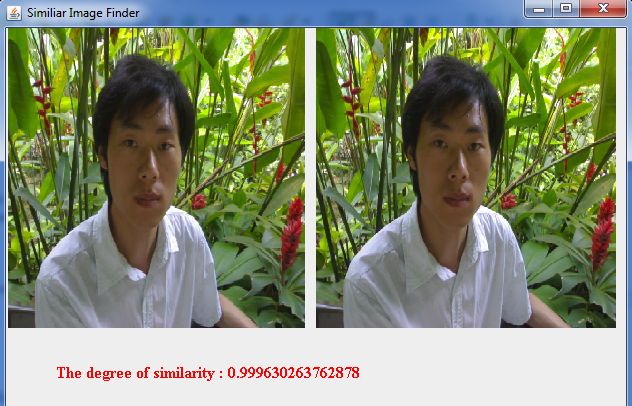图像相似度(测试)--基于直方图特征的图像搜索
转自:http://blog.csdn.net/jia20003/article/details/7771651#comments
图像处理之相似图片识别(直方图应用篇)
算法概述:
首先对源图像与要筛选的图像进行直方图数据采集,对采集的各自图像直方图进行归一化再
使用巴氏系数算法对直方图数据进行计算,最终得出图像相似度值,其值范围在[0, 1]之间
0表示极其不同,1表示极其相似(相同)。
算法步骤详解:
大致可以分为两步,根据源图像与候选图像的像素数据,生成各自直方图数据。第二步:使
用第一步输出的直方图结果,运用巴氏系数(Bhattacharyya coefficient)算法,计算出相似程
度值。
第一步:直方图计算
直方图分为灰度直方图与RGB直方图,对于灰度图像直方图计算十分简单,只要初始化一
个大小为256的直方图数组H,然后根据像素值完成频率分布统计,假设像素值为124,则
H[124] += 1, 而对于彩色RGB像素来说直方图表达有两种方式,一种是单一直方图,另外一
种是三维直方图,三维直方图比较简单明了,分别对应RGB三种颜色,定义三个直方图HR,
HG, HB, 假设某一个像素点P的RGB值为(4, 231,129), 则对于的直方图计算为HR[4] += 1,
HG[231] += 1, HB[129] += 1, 如此对每个像素点完成统计以后,RGB彩色直方图数据就生成了。
而RGB像素的单一直方图SH表示稍微复杂点,每个颜色的值范围为0 ~ 255之间的,假设
可以分为一定范围等份,当8等份时,每个等份的值范围为32, 16等份时,每个等份值范
围为16,当4等份时候,每个等份值的范围为64,假设RGB值为(14, 68, 221), 16等份之
后,它对应直方图索引值(index)分别为: (0, 4, 13), 根据计算索引值公式:index = R + G*16 + B*16*16
对应的直方图index = 0 + 4*16 + 13 * 16 * 16, SH[3392] += 1
如此遍历所有RGB像素值,完成直方图数据计算。
第二步:巴氏系数计算,计算公式如下:
其中P, P’分别代表源与候选的图像直方图数据,对每个相同i的数据点乘积开平方以后相加
得出的结果即为图像相似度值(巴氏系数因子值),范围为0到1之间。
程序效果:

相似度超过99%以上,极其相似
相似度为:72%, 一般相似
程序直方图计算源代码如下:
- public void setGreenBinCount(int greenBinCount) {
- this.greenBins = greenBinCount;
- }
- public void setBlueBinCount(int blueBinCount) {
- this.blueBins = blueBinCount;
- }
- public float[] filter(BufferedImage src, BufferedImage dest) {
- int width = src.getWidth();
- int height = src.getHeight();
- int[] inPixels = new int[width*height];
- float[] histogramData = new float[redBins * greenBins * blueBins];
- getRGB( src, 0, 0, width, height, inPixels );
- int index = 0;
- int redIdx = 0, greenIdx = 0, blueIdx =0;
- int singleIndex = 0;
- float total = 0;
- for(int row=0; row<height; row++) {
- int ta = 0, tr = 0, tg =0, tb = 0;
- for(int col=0; col<width; col++) {
- index = row * width + col;
- ta = (inPixels[index] >> 24) &0xff;
- tr = (inPixels[index] >> 16) & 0xff;
- tg = (inPixels[index] >> 8) &0xff;
- tb = inPixels[index] & 0xff;
- redIdx = (int)getBinIndex(redBins, tr,255);
- greenIdx = (int)getBinIndex(greenBins, tg,255);
- blueIdx = (int)getBinIndex(blueBins, tb,255);
- singleIndex = redIdx + greenIdx * redBins + blueIdx * redBins * greenBins;
- histogramData[singleIndex] += 1;
- total += 1;
- }
- }
- // start to normalize the histogram data
- for (int i =0; i < histogramData.length; i++)
- {
- histogramData[i] = histogramData[i] / total;
- }
- return histogramData;
- }
- /**
- * Bhattacharyya Coefficient
- * http://www.cse.yorku.ca/~kosta/CompVis_Notes/bhattacharyya.pdf
- *
- * @return
- */
- public double modelMatch() {
- HistogramFilter hfilter = new HistogramFilter();
- float[] sourceData = hfilter.filter(sourceImage,null);
- float[] candidateData = hfilter.filter(candidateImage,null);
- double[] mixedData =new double[sourceData.length];
- for(int i=0; i<sourceData.length; i++ ) {
- mixedData[i] = Math.sqrt(sourceData[i] * candidateData[i]);
- }
- // The values of Bhattacharyya Coefficient ranges from 0 to 1,
- double similarity = 0;
- for(int i=0; i<mixedData.length; i++ ) {
- similarity += mixedData[i];
- }
- // The degree of similarity
- return similarity;
- }

